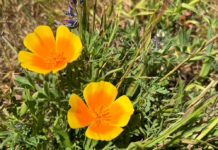It’s springtime again and young wildlife are emerging from their dens and nests and beginning to learn the ways of the world. Because of this increase in wildlife activity, the California Department of Fish and Wildlife (CDFW) reminds people to leave young wildlife alone if they come across them in the wild. The improper handling of young wildlife is a problem in California and across the nation, especially in spring.
“Each species cares for and trains its young in unique ways,” said Nicole Carion, CDFW’s statewide coordinator for wildlife rehabilitation. “Some animals, such as deer, will leave their young for hours at a time while they forage for food. A small fawn stashed in the bushes by its mother may look vulnerable and defenseless, but it is likely healthy and well cared for and should not be disturbed.”
Not disturbing young wildlife also means keeping your pets on a leash. If a fawn or other young animal is startled by a roaming dog, it may abandon its nest or den and lose its way.
“If a wild animal appears in distress, the best course of action is to call a wildlife rehabilitator, who can determine whether there is a need for a rescue,” said Carion. “Rehabilitators are trained to provide care for wild animals so they retain their natural fear of humans and do not become habituated or imprinted.”
It’s also important to remember that wild animals can cause serious injury with their sharp claws, hooves and teeth. In addition, they can carry ticks, fleas and lice, and can transmit diseases to humans, including rabies and tularemia, so it is best to leave the responsibility for intervention to CDFW personnel or permitted wildlife rehabilitators. In addition, in California it is illegal to feed wild animals, to keep orphaned or injured wildlife for more than 48 hours or to keep native wildlife as pets.
Here are some commonly asked questions:
Q: A very small juvenile bird has fallen from its nest in a tree in my backyard. I am afraid something my might happen to it if I leave it there on the ground. Should I bring it into the house and feed it until it is able to fly?
A: No. The best thing to do is put the bird carefully back into the nest (or the nest itself back into the tree). But, do this only if you can do it safely. Don’t worry about getting your scent on the bird. Also, some birds that appear to have fallen from the nest are actually recently fledged and are learning to fly. They will not stay in the nest.
Q: There is a young scrub jay in my backyard and it seems to be having difficulty flying. I am afraid that either my dog or cat will get it. Should I bring it inside and feed it until it is able to fly?
A: No. As a fledgling, it had enough feathers to leave the nest. This means it is old enough to learn to fly, which it will rapidly begin to do. Leave the bird alone, and keep your dog or cat in the house for a few hours so it won’t disturb the bird.
Q: This morning I found an “abandoned” fawn near the edge of a field on my property. I brought the fawn into my house to save it, but I don’t know how to care for it. What should I do?
A: In most cases, the fawn probably isn’t abandoned. Immediately take the fawn back to the spot where you found it and leave it there. Do not feed the fawn anything. Cow’s milk will cause diarrhea and dehydration. Fawns require a special formula that cannot be purchased at a store. The mother should come back again looking for the fawn. Even one to two days after removal from the wild, fawns have been successfully reunited with their mothers by returning them to the place where they were found. When you picked up the fawn, the mother was probably not far away. Usually, young fawns are quite safe when left alone for the day by their mother.
Q: The cat just caught and killed a mother bird. The baby birds are now obviously orphaned. Shouldn’t I take them to a wildlife rehabilitator?
A: Most songbird young are cared for by both parents. If one of the parent birds is killed, the surviving adult can successfully raise the chicks. Even if you think both parents are dead, call the rehabilitator for advice before taking any direct action with the young birds
Q: While doing yard work, I accidentally disturbed a nest of baby rabbits at the far corner of my property. They seemed so young and scared. I waited, but saw no sign of their mother. Should I rescue them?
A: They do not need to be rescued. The mother will not return as long as you remain at the nest. Just return the nest back to its original condition as best as you can and leave. The mother will return and care for the young. Cottontail rabbits leave their young for many hours while eating, but return for a brief time to nurse the young. As with other young wildlife, it is best to leave them alone.
To learn more about how to live responsibly with wildlife, including keeping food and garbage secured and not feeding wild animals, please visit CDFW’s Keep Me Wild website at www.keepmewild.org. For more information on wildlife rehabilitation, please visit www.wildlife.ca.gov/conservation/laboratories/wildlife-investigations/rehab/facilities.
Submitted by the California Department of Fish and Wildlife.
57
F
Healdsburg
May 27, 2025









